Members Area
It is with great sadness we bid farewell to Douglas (Douggie) Slocombe, one of the film industry’s premiere cinematographers.
Douggie passed away in the early hours of Monday 22nd February at Chelsea and Westminster Hospital following complications resulting from a fall some weeks ago. He will be deeply missed by us all.
We spoke to Douggie following his celebration of his 103 birthday in hospital on 10th February and he was as erudite and lucid as ever, no mean feat for a centenarian.
He started as a photojournalist for Life magazine and the Parish Match newspaper before World War II, during which he became a newsreel cameraman, and thence to Ealing studios as a camera operator.
Over his career as a Cinematographer he was lauded for his photography of such films as The Servant (1963), The Guns at Batasi (1964), The Blue Max (1966), The Lion in Winter (1968), Julia (1977), Travels with My Aunt (1972), Jesus Christ Superstar (1973), The Great Gatsby (1974) Rollerball (1975), Raiders of the Lost Ark (1981), Indiana Jones and the Temple of Doom (1984), for which he garnered numerous awards including three Oscar nominations. He was noted for never having used a light meter, an almost indispensable tool for most cinematographers.
A Founder Member of the British Society of Cinematographers which was formed in 1949, he was awarded the BSC Lifetime Achievement Award in 1995.
Feature image photo credit: Richard Blanshard
A few words below from his dear friend Robin Vidgeon BSC followed by a tribute from Phil Meheux BSC.
I had the honour and great pleasure of working with Douggie and knowing him as a great friend for over 50 years, and as one of the worlds greatest Directors of Photography. His list of films is huge, and he worked hand in hand with many of the worlds greatest directors.
Our thoughts go out to his lovely daughter Georgina.
God Bless you Douggie
Robin
DOUGLAS SLOCOMBE OBE BSC
10.02.1913 - 22.02.2016
Tribute by Phil Meheux BSC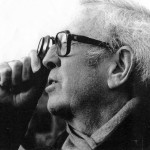
Douglas Slocombe, OBE, BSC, was born on the 10th February 1913 in London, the son of journalist/writer George Slocombe. His father was a celebrated Paris correspondent who interviewed Hitler and Mussolini, and was instrumental in securing Gandhi’s release from jail. Douggie was raised in France and as a boy, was given a Kodak Box Brownie camera and a couple of years later a French Pathé Baby, 9.5mm. Shooting stills with one and movies with the other gave him his first real interest in movies. Like most youngsters, he used to go to see every single film and was always spell-bound by them dreaming that one day, he would be in films.
Having finished his education, his father arranged for Douggie to meet with Alexander Korda – a Hungarian film producer who was based in London but working in Paris. Korda did offer a job at the Paris Film Studios but Douggie was unable to get a work permit at that time.
He came back to England but failed to get any better luck and after some parental help ended up in Fleet street working as a sub-editor and French correspondent, perusing the French newspapers for new stories. He soon became bored with that and started taking photographs around London with his Leica camera and managed to place them in various magazines such as Paris Match, The Illustrated London News and Picture Post.
This prompted him to suddenly switch from journalism, "in which I felt I could never follow in my father's footsteps", to photojournalism.
Looking for adventure, in 1939, he saw the headline, “Danzig - A Danger Point of Europe.” He went to Life Magazine and got some money from them and went to Danzig and found himself in an absolute hotbed of Nazi intrigue. “There were storm-troopers marching up and down the streets - brown shirts, black shirts - children were marching up and down in Hitler uniforms, all bearing little daggers in their socks, Jews being beaten up, Jewish shops being smashed, there was a whole lot of things going on which I covered in these photographs.”
After about three weeks, he came back to London and was approached by a documentary film maker, Herbert Kline who was very keen to know what he had seen. He was making a documentary called LIGHTS OUT IN EUROPE saying the script was being written daily by Hitler, Mussolini, Roosevelt and Chamberlain. Kline felt that they didn't have any sort of German menacing film material so, would Douggie go back with a movie-camera?
Given a spring loaded 35mm Eyemo and some film, Douggie returned to Danzig where things had hotted up a lot and started shooting moving pictures, redoing what he had done in stills. He took shots of Goebbels addressing a rally, and escaped from an aggressive auditorium of Brownshirts by scurrying under their outstretched arms as they “Sieg Heiled.” He filmed the burning of a synagogue, for which he was imprisoned in a Gestapo cell but managed to talk his way out of it. Realising it was time to leave, he made his way into Poland and met with Kline and shot some more material with the Polish Army and was there on the night of the 31st of August when the first planes and bombs starting coming down. That was Douggie’s real baptism of fire, both in film and in terms of war.
He attempted to escape from Poland by rail, but the train was attacked from the air. After weeks traveling across the war-torn countryside, he reached the Latvian border and returned to London via Stockholm.
His experiences brought him into contact with the Ministry of Information who offered him the possibility to film all three services for them. He filmed on several Atlantic convoys, dozens of destroyers and did a lot of filming with the Fleet Air Arm and a certain amount with the Army as well.
At that time Ealing Studios under the aegis of Michael Balcon was making war propaganda films with [Alberto] Cavalcanti who got to hear about Douggie and suggested that the Ministry of information could allow him to shoot some background material for their war effort. So, Douggie was able to combine shooting for Cavalcanti with the Ministry of Information work.
This gave him a foothold in Ealing as a one-man band, second unit cinematographer, but it did give him an idea of what was happening on the big screen with big cameras. However, he still kept the 35mm Eyemo camera and used it for his second unit work.
He was taken into the studio system at the end of the war and now that he had a foothold in Ealing, they asked him to shoot a whole series of war time documentaries like FIND, FIX AND STRIKE [1942 directed by Compton Bennett] about training Fleet Air Arm pilots; FOR THOSE IN PERIL [1944 directed by Charles Crichton] about high speed launches picking up pilots who ditched in the channel and where Douggie first met Charles Crichton as a director with whom he was later to do a number of Ealing films once he became a fully fledged cameraman.
At first he started operating with Cavalcanti as director but in Douggie’s own words, “I was suddenly given a Mitchell Camera, which I don't think I'd ever seen before, which in those days had a side-finder and I don't think I was terribly good with a side-finder. I don't think I ever adjusted it properly and I would sometimes get what I thought was a beautifully composed shot in the finder and find that the lens itself was projecting quite a different image!
On several occasions, I managed to get quite a number of things into the composition that weren't supposed to be there, including the long suffering Wilkie Cooper himself who was, unbeknownst to me, walking alongside of the camera with a hand-held lamp in order to fill in some of the shadows. He was in the blind spot of the camera and of course I wasn't to know he was there. But I don't think any good, experienced operator would have done that. It was after that, that they decided that maybe operating on a studio camera wasn't the best thing for me.”
He was then allowed to light and photograph on his own. His first proper feature credit was DEAD OF NIGHT [1945 directed by Cavalcanti, Charles Crichton, Robert Hamer and Basil Dearden] which he shared with two other cameramen [Stan Pavey and Jack Parker]. It was the beginning of a 17-year association with Ealing where Dougie became the pre-eminent house cinematographer. “Ealing was rather like Hollywood in the old days,” Dougie recalls. “It had a number of cameramen and directors and writers under contract, so there was a continuity of production. We all knew each other so well, we’d spend the evenings together in the local pub. It was very much a community.”
He started work, without any formal training, as cinematographer. Knowing from his newsreel experience how to shoot in natural light, he now had to learn, on his feet, how to simulate that effect in the studio. Likewise never having seen anyone shoot a night scene, he had to improvise from observation and early experience as a stills photographer. Ealing remains for him a memory of passionate debate and fervent exploration. With Alexander Mackendrick, Robert Hamer and Charles Crichton he found directors who in their different ways were similarly working “on the edge” and to an extent against the grain.
Looking back at the Ealing days, his often says his favourite film was KIND HEARTS AND CORONETS [1949 directed by Robert Hamer]. He always liked films with a literary flavour and “something in which one sensed good writing apart from anything else and KIND HEARTS certainly fulfilled those requirements. It was a tremendously wicked script, and it makes me laugh to this day and I still remember some of the lines in it, even with my rocky memory.”
With SARABAND FOR DEAD LOVERS [1948 Director Basil Dearden], his first colour film, he was determined to bring to it the same scale of contrast as he had used with black-and-white film, rather than follow the rules for shooting with Technicolor, a decision not welcomed at the time. The final effect was romantic and expressive, and despite the film’s lack of success, he looks back with affection on the technical complexity of the Technicolor process and relishes the fact that printing from Technicolor negatives remains pure and accurate despite the passage of time.
ON CAGE OF GOLD, 1950 directed by Basil Dearden, he began working with Chic Waterson, who remained his operator for some twenty-five years.
After Ealing’s demise in the late 1950s, Dougie freelanced for different companies, at one point signing a three-year contract with 20th Century Fox that resulted in a series of CinemaScope spectaculars, from the seafaring adventure of A HIGH WIND IN JAMAICA [1965 Alexander Mackendrick] to the high flying of WWI-set biplane saga THE BLUE MAX [1966 John Guillerman] and the African intrigue of GUNS AT BATASI [1964 John Guillerman].
Perhaps his most striking work from this mid-’60s period lies in the unsettling b&w atmosphere of Joe Losey and Harold Pinter’s THE SERVANT, whose gradually more expressionistic images convey the perverse shifting power balance between “master” [James Fox] and scheming “gentleman’s gentleman” [Dirk Bogarde].
Dougie was often attracted to projects that invited multiple visual approaches. For Huston’s sadly studio-truncated drama FREUD, he deployed “at least four different techniques within the film, all in b&w, to separate the flashbacks, the biographical story, dream sequences and so forth.” This movie proved the most satisfying and frustrating film of his career. Satisfying because it contained what, in his own estimation, was his best work; frustrating because the company for which it was shot destroyed most of it.
It was a troubled production from the word go and not helped by its leading actor, Montgomery Clift being unable to remember his lines and mixing his alcohol with barbiturates and amphetamines. The shoot over-ran by several months and Universal responded to the increased costs by attempting to sue Clift, and the legal action made him virtually unemployable.
However, at a screening for studio executives, Huston announced that the film was exactly as he wanted it to be seen in cinemas. “I remember,” says Dougie, “the Universal chaps sitting next me saying under their breath: that’s what he thinks.”
They sliced it down to 90 minutes, and released it as FREUD: THE SECRET PASSION, “in case,” notes Dougie, “people thought it was the name of a frozen food.”
Given his love of literary scripts it did not at first seem a natural fit when Spielberg asked Douggie to shoot the epic RAIDERS OF THE LOST ARK. Though very intrigued, Slocombe was somewhat taken aback by Spielberg’s favouring “a very, very tight schedule, enormous numbers of setups every day, very large sets that he didn’t want laboriously lit. It was challenging in terms of keeping on schedule – or rather ahead of schedule, as was his wont.” Nonetheless, he soon grew to consider this collaboration among his most enjoyable, one that carried on through two sequels.
In later life, a botched course of laser treatment robbed him of the use of his right eye - the one with which he gazed through the viewfinder - and the vision in his left eye has been deteriorating since being injured in a jeep crash during a location recce. “Until this happened I never worried about that,” he says, brightly. “So long as you’ve got one good eye, the other one is just back-up.”
Although virtually blind in later years, he still kept an erudite and lucid mind and almost until the last days he would turn up at every BSC function aided by his devoted daughter, Georgina.
Other credits not mentioned in the text are: THE L-SHAPED ROOM; ROBBERY; THE BLUE MAX; GUNS AT BATASI; THE LION IN WINTER; THE ITALIAN JOB; THE MUSIC LOVERS; MURPHY’S WAR; TRAVELS WITH MY AUNT; JULIA; JESUS CHRIST SUPERSTAR; ROLLERBALL; THE GREAT GATSBY; CLOSE ENCOUNTERS OF THE THIRD KIND (INDIAN SEQUENCE); NIJINSKY; NEVER SAY NEVER AGAIN; LADY JANE.
BSC Award [1963] & BAFTA Film Award [1964] for ‘The Servant’;
BAFTA Film Award nom [1965] for ‘Guns at Batasi’;
BAFTA Film Award nom [1967] for ‘The Blue Max’;
BSC Award [1968] & BAFTA Film Award nom [1969] for ‘The Lion in Winter’;
BSC Award [1973] & BAFTA Film Award nom [1974] for ‘Jesus Christ Superstar’;
‘Oscar’ AA nom [1972] & BAFTA Film Award nom [1974] for ‘Travels with My
Aunt’;
BSC Award [1974] & BAFTA Film Award [1975] for ‘The Great Gatsby’;
BAFTA Film Award nom [1976] for ‘Rollerball’;
‘Oscar’ AA nom [1977], LAFCA Award [1977], BSC Award [1978] & BAFTA Film
Award [1979] for ‘Julia’;
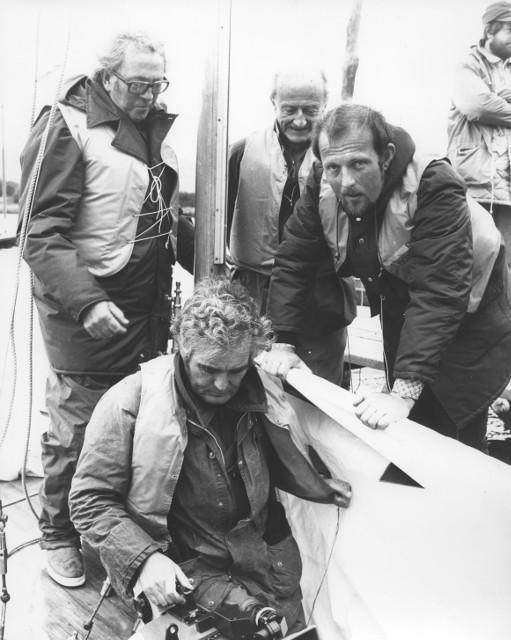
L to R: Doug Slocombe, Fred Zinnemann, Chic Waterson (crouching) and Robin Vidgeon - Julia 1977
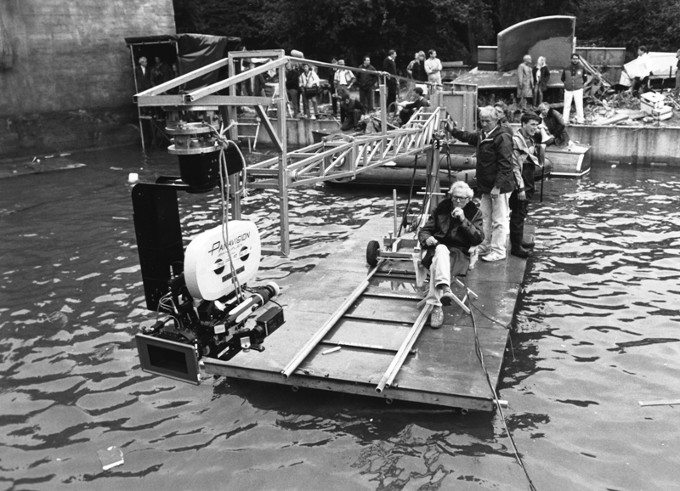
Douggie on 'Raiders of the Lost Ark' 1981 - Elstree
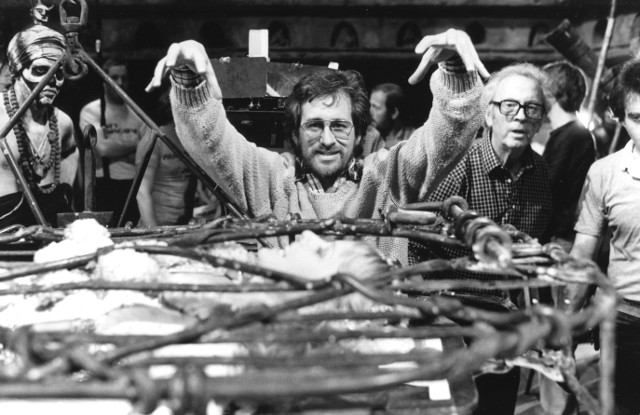
Centre: Steven Spielberg with Douggie, Robin Vidgeon in b/g - Indiana Jones and The Temple of Doom 1984
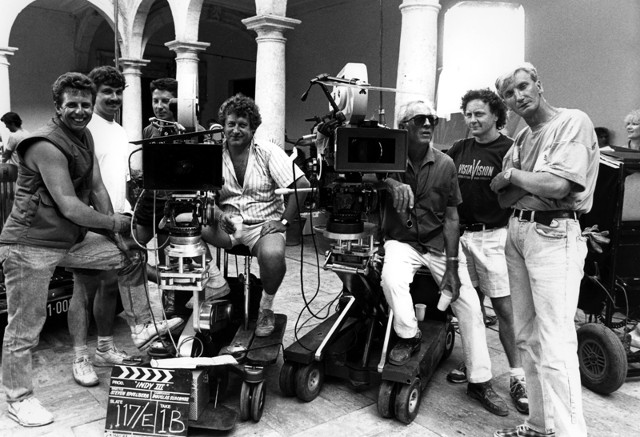
1988 in Almeria on 'Indiana Jones the Last Crusade' (1989) from L to R: Simon Hume, Clive Mackey, John Flemming, Dave Worley, Douggie, Martin Kenzie and Dennis Brock
Designed for all Freelancers involved in film making with a passion for the moving image
Uniting cinematographers worldwide
Member profiles and agent details